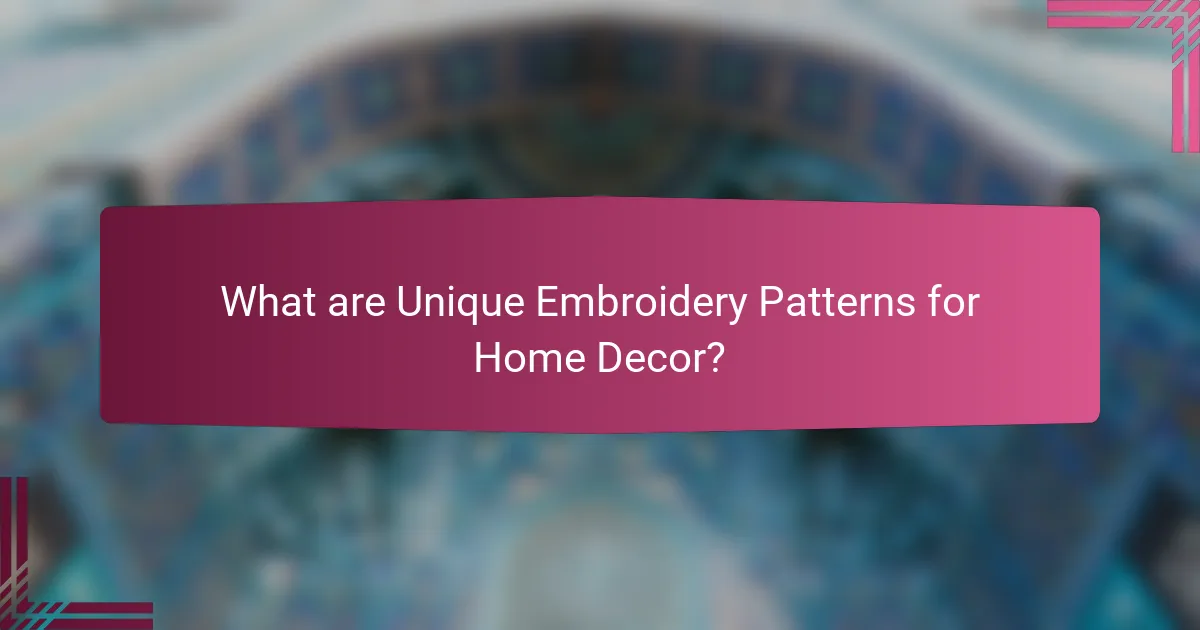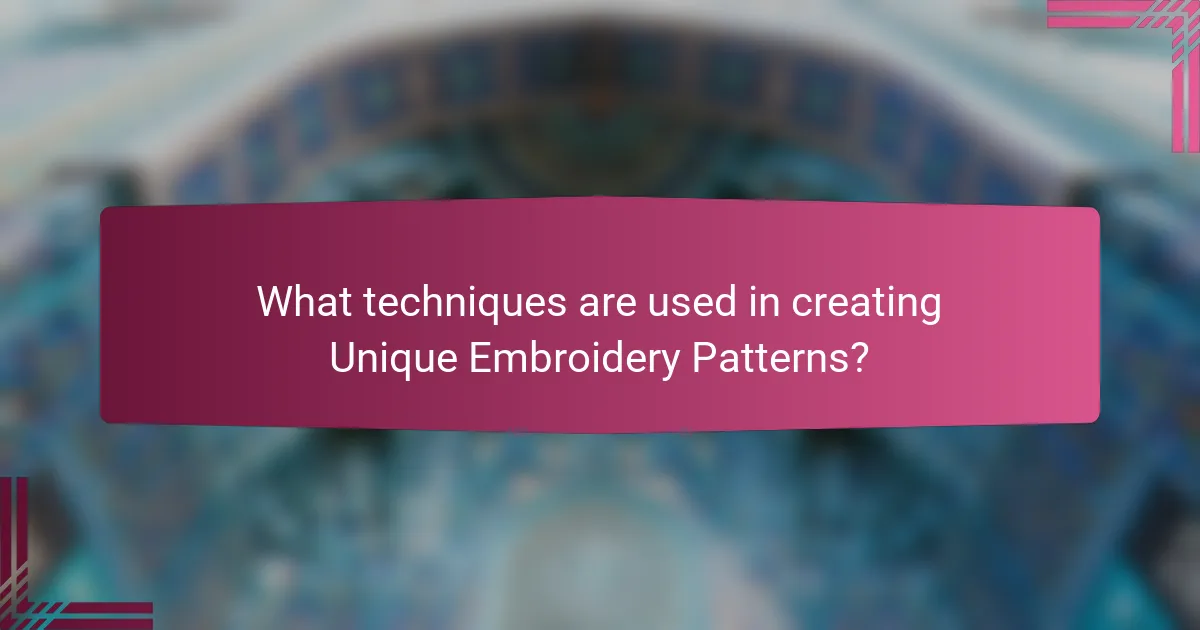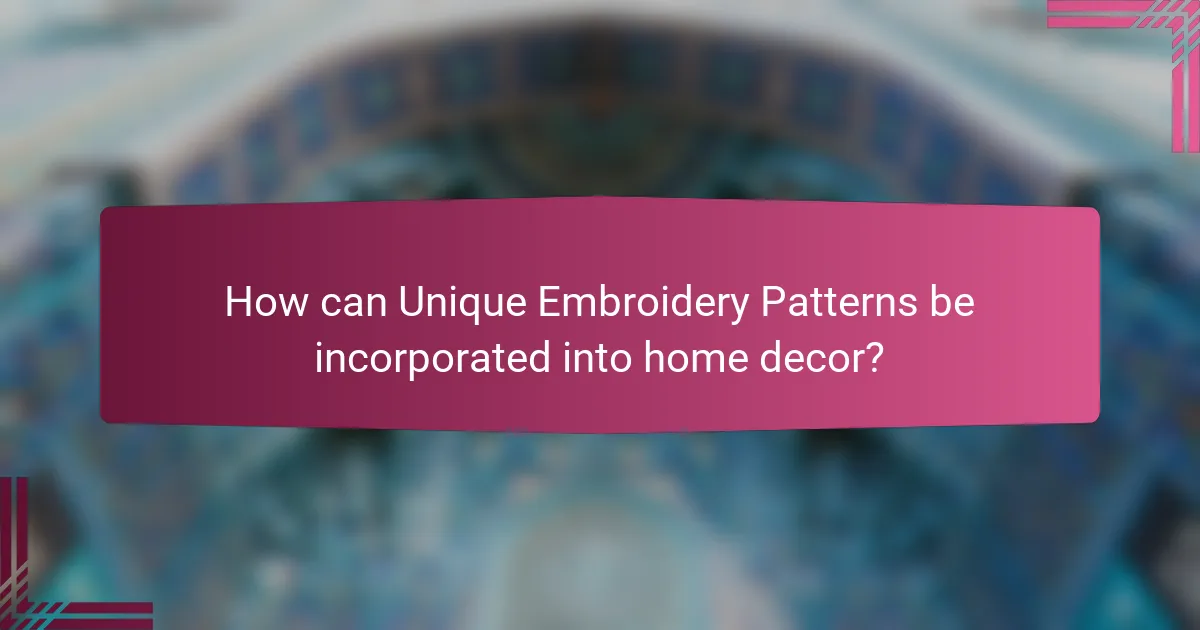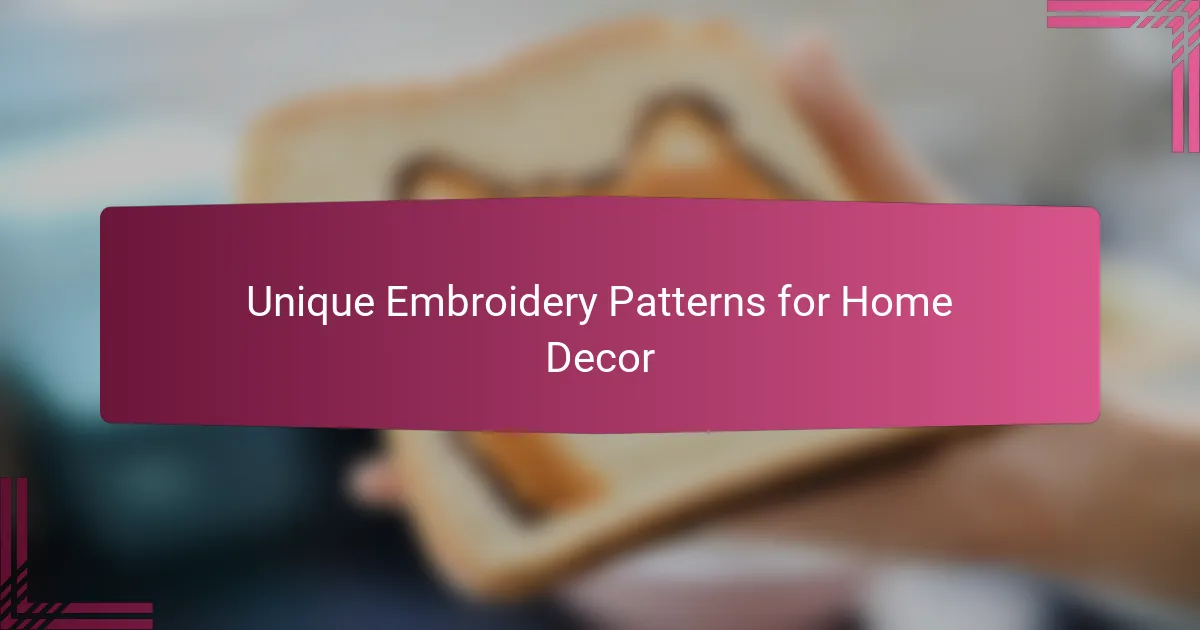
What are Unique Embroidery Patterns for Home Decor?
Unique embroidery patterns for home decor are distinctive designs that enhance interior aesthetics. These patterns often incorporate intricate motifs, such as floral, geometric, and abstract shapes. They can be applied to various textiles, including cushions, wall hangings, and table runners. Unique patterns stand out due to their originality and craftsmanship. Many artisans create custom designs, making each piece one-of-a-kind. Popular trends include modern minimalist styles and traditional folk art influences. The use of vibrant colors and textures adds depth to home environments. Unique embroidery patterns contribute to personalized and artistic home decor.
How do Unique Embroidery Patterns enhance home aesthetics?
Unique embroidery patterns enhance home aesthetics by adding visual interest and texture. These patterns can serve as focal points in a room. They often reflect personal style and cultural heritage. Unique designs can create a sense of warmth and comfort. According to a study by the American Society of Interior Designers, textiles significantly impact perceived space. Moreover, unique embroidery can complement existing decor themes. This versatility allows for creative expression in home design. The intricate details of embroidery can also draw attention and spark conversation.
What types of styles are represented in Unique Embroidery Patterns?
Unique embroidery patterns encompass various styles, including traditional, contemporary, and ethnic designs. Traditional styles often feature intricate motifs and historical techniques, such as crewelwork and cross-stitch. Contemporary styles may include minimalist designs with bold colors and geometric shapes. Ethnic styles represent cultural heritage, showcasing patterns like paisley, mandala, or tribal designs. Each style reflects distinct aesthetic values and craftsmanship. For instance, traditional embroidery often uses natural dyes and time-honored stitching methods. Contemporary patterns may prioritize innovation and personal expression. Ethnic designs frequently draw inspiration from folklore and regional artistry. These diverse styles contribute to the rich tapestry of unique embroidery patterns in home decor.
How do color choices impact the perception of Unique Embroidery Patterns?
Color choices significantly influence the perception of unique embroidery patterns. Different colors evoke specific emotions and associations. Warm colors, such as red and orange, can create a sense of energy and warmth. Cool colors, like blue and green, tend to evoke calmness and serenity.
The contrast between colors can enhance the visibility of intricate patterns. High contrast can draw attention to the design, making it appear more dynamic. Conversely, low contrast may create a more subtle and sophisticated look.
Research indicates that color combinations can affect viewer engagement. A study by the Institute for Color Research found that people make a judgment about an environment within 90 seconds, largely based on color. This highlights the importance of strategic color choices in embroidery for home decor.
Why are Unique Embroidery Patterns popular in home decor?
Unique embroidery patterns are popular in home decor because they add personalized and artistic touches to living spaces. These patterns allow homeowners to express individuality and creativity. Unique designs can enhance the aesthetic appeal of various items, such as cushions, wall hangings, and table linens. The versatility of embroidery makes it suitable for different styles, from traditional to modern. Additionally, handmade embroidery often carries a sense of craftsmanship and quality. This craftsmanship can create a warm and inviting atmosphere in a home. Unique embroidery patterns also serve as conversation starters, reflecting personal stories or cultural heritage. The growing trend of DIY home decor has further increased interest in unique embroidery as a creative outlet.
What cultural influences shape Unique Embroidery Patterns?
Unique embroidery patterns are shaped by various cultural influences. Regional traditions play a significant role in defining these patterns. For example, Indian embroidery is known for its vibrant colors and intricate designs. Mexican embroidery often features floral motifs and bold patterns. Middle Eastern embroidery incorporates geometric designs and calligraphy. Historical events also influence patterns, reflecting the stories and heritage of communities. Additionally, the availability of materials affects the style and technique used in different cultures. Each culture’s unique history and environment contribute to the distinctiveness of its embroidery patterns.
How do Unique Embroidery Patterns reflect personal style?
Unique embroidery patterns reflect personal style by showcasing individual creativity and preferences. These patterns often incorporate specific colors, designs, and motifs that resonate with a person’s identity. For instance, floral designs may indicate a love for nature, while geometric patterns can reflect a modern aesthetic. The choice of fabric and stitching technique further emphasizes personal taste. Additionally, unique patterns can convey cultural heritage or personal stories, making them meaningful. Studies show that personalized decor enhances emotional connection to spaces. Therefore, unique embroidery patterns serve as a visual representation of one’s style and values.

What techniques are used in creating Unique Embroidery Patterns?
Unique embroidery patterns are created using various techniques. Common techniques include free-motion embroidery, which allows for intricate designs by moving the fabric freely under the needle. Another method is hand embroidery, where artisans use needles and threads to create detailed patterns manually. Appliqué involves stitching fabric pieces onto a base fabric to form a design. Stumpwork adds a three-dimensional effect through raised embroidery techniques. Additionally, digital embroidery uses computerized machines to produce precise and complex patterns efficiently. These techniques enable the creation of unique and personalized designs suitable for home decor.
What are the most common embroidery techniques for home decor?
The most common embroidery techniques for home decor include cross-stitch, satin stitch, and embroidery appliqué. Cross-stitch is popular for creating intricate designs on fabric. It involves stitching X-shaped patterns to form images or motifs. Satin stitch provides a smooth finish and is used for filling shapes with color. This technique is often seen in decorative pillows and wall hangings. Embroidery appliqué combines different fabrics to create layered designs. It adds texture and dimension to home decor items like quilts and table runners. Each of these techniques enhances the aesthetic appeal of home decor while allowing for personal expression.
How does hand embroidery differ from machine embroidery?
Hand embroidery involves stitching by hand, while machine embroidery uses a sewing machine. Hand embroidery allows for more intricate designs and personal touches. It often requires more time and skill to complete. Machine embroidery is faster and can produce uniform patterns efficiently. Hand embroidery tends to have a unique, artistic quality. Machine embroidery offers consistency and precision across multiple pieces. Each method has its own advantages depending on the desired outcome.
What techniques create texture in Unique Embroidery Patterns?
Techniques that create texture in unique embroidery patterns include layering, knotting, and using varied stitch types. Layering involves stacking multiple threads or fabrics to add depth. Knotting introduces raised elements that enhance tactile contrast. Varied stitch types, such as satin, French knots, and chain stitches, contribute diverse surface textures. These techniques are commonly used in embroidery to create visually engaging designs. The combination of these methods allows for intricate and unique patterns in home decor.
What materials are essential for crafting Unique Embroidery Patterns?
Essential materials for crafting unique embroidery patterns include fabric, embroidery thread, needles, and hoops. Fabric serves as the base for the embroidery design. Common fabric choices are cotton, linen, and canvas. Embroidery thread, often made from cotton or silk, provides color and texture. Needles, specifically designed for embroidery, have larger eyes to accommodate thicker threads. Embroidery hoops keep the fabric taut during stitching. Scissors are necessary for trimming threads and finishing touches. Additionally, patterns or templates guide the design process. Each of these materials plays a crucial role in achieving intricate and unique embroidery patterns.
What fabrics work best for embroidery projects?
Cotton and linen are the best fabrics for embroidery projects. They provide a stable surface for stitching. Both fabrics have a tight weave that holds threads well. Cotton is widely available and comes in various weights. Linen offers a unique texture and durability. Silk is also suitable but can be more challenging to work with. Polyester blends are affordable and easy to care for. These fabrics are commonly recommended by embroidery experts for their compatibility.
How do thread types affect the outcome of embroidery patterns?
Thread types significantly influence the outcome of embroidery patterns. Different thread materials, such as cotton, polyester, and silk, offer varying textures and finishes. Cotton threads provide a matte finish, while polyester threads are more vibrant and durable. Silk threads create a luxurious sheen, enhancing the visual appeal of designs. The thickness of the thread also affects stitch density and overall design clarity. Thicker threads may create bolder, more pronounced patterns, while thinner threads allow for intricate detailing. Additionally, the colorfastness of the thread type impacts the longevity of the design’s colors. For instance, polyester threads resist fading better than cotton threads. Therefore, the choice of thread type is crucial in achieving the desired aesthetic and durability in embroidery patterns.

How can Unique Embroidery Patterns be incorporated into home decor?
Unique embroidery patterns can be incorporated into home decor through various applications. These patterns can be used on throw pillows to add texture and personality. Wall hangings featuring unique embroidery can serve as focal points in living spaces. Table runners adorned with intricate embroidery enhance dining experiences. Curtains with embroidered designs can provide a custom touch to windows. Additionally, framed embroidery pieces can be displayed as artwork. Using unique embroidery in these ways creates a cohesive and inviting atmosphere. Studies show that personalized decor can increase feelings of comfort and satisfaction in home environments.
What are the best applications for Unique Embroidery Patterns in home design?
Unique embroidery patterns can enhance various aspects of home design. They are best applied in decorative pillows, adding texture and visual interest to living spaces. Wall hangings featuring unique embroidery can serve as focal points in rooms. Table linens, such as embroidered tablecloths and napkins, can elevate dining experiences. Curtains with unique embroidery patterns can create a personalized atmosphere while providing privacy. Upholstered furniture can showcase unique embroidery, making pieces stand out. Additionally, unique embroidery can be used in bed linens, contributing to a cozy and stylish bedroom. These applications not only beautify spaces but also reflect personal style and creativity.
How can Unique Embroidery Patterns be used in wall art?
Unique embroidery patterns can be used in wall art by framing them as textile pieces. This method highlights the intricate designs and craftsmanship involved in embroidery. Wall art featuring these patterns adds texture and color to interior spaces. Additionally, unique embroidery can be combined with other materials, such as wood or canvas, for a mixed-media effect. Displaying these pieces in various sizes can create a cohesive gallery wall. The use of unique patterns allows for personal expression, making each piece one-of-a-kind. This approach to wall art enhances the overall aesthetic of a room while showcasing artistic skills.
What role do Unique Embroidery Patterns play in textile furnishings?
Unique embroidery patterns enhance textile furnishings by adding aesthetic appeal and personalization. These patterns can transform ordinary fabrics into unique decorative elements. They reflect cultural heritage and artistic expression, often showcasing intricate designs. Unique embroidery patterns can also convey themes or moods, influencing the overall ambiance of a space. According to a study by the Textile Research Journal, embroidered textiles often increase perceived value and quality. This demonstrates their significant role in elevating home decor.
What tips can enhance the use of Unique Embroidery Patterns in decor?
Incorporating unique embroidery patterns in decor can be enhanced by selecting complementary color schemes. This creates a cohesive look that highlights the patterns. Using embroidery as focal points in specific areas, like throw pillows or wall art, draws attention effectively. Layering different textures alongside embroidery adds depth to the decor. Incorporating unique frames for embroidered pieces can elevate their visual impact. Mixing embroidery styles, such as geometric with floral, introduces variety and interest. Regularly rotating embroidered items keeps the decor fresh and engaging. Finally, considering the scale of embroidery in relation to the space ensures balance and harmony in the overall design.
How can one choose the right pattern for a specific room?
To choose the right pattern for a specific room, consider the room’s purpose and existing decor. The pattern should complement the room’s function, such as calming patterns for bedrooms or vibrant patterns for playrooms. Analyze the color scheme of the room. Patterns should harmonize with existing colors to create a cohesive look. Evaluate the room’s size; larger patterns can overwhelm small spaces, while intricate patterns may get lost in large rooms. Assess the style of the room. Traditional rooms benefit from classic patterns, while modern spaces suit geometric or abstract designs. Finally, consider personal taste. The chosen pattern should resonate with the individual’s aesthetic preferences.
What maintenance practices ensure the longevity of embroidered decor?
To ensure the longevity of embroidered decor, proper maintenance practices are essential. Regular dusting with a soft cloth prevents dirt accumulation. Washing should be done gently by hand using mild detergent. Avoid harsh chemicals that can damage the threads. Air drying is recommended to maintain shape and prevent shrinkage. Storing embroidered items in a cool, dry place protects them from moisture and pests. Avoid direct sunlight to prevent fading of colors. These practices help preserve the quality and appearance of embroidered decor over time.
Unique embroidery patterns for home decor are distinctive designs that enhance the aesthetic appeal of interior spaces. This article explores how these patterns, characterized by intricate motifs and vibrant colors, contribute to personalized home decor, reflecting individual style and cultural heritage. It discusses various styles and techniques used in creating unique embroidery, the impact of color choices on perception, and the best applications for incorporating these patterns into home furnishings. Additionally, it provides tips for selecting appropriate patterns for different rooms and maintenance practices to ensure longevity.
